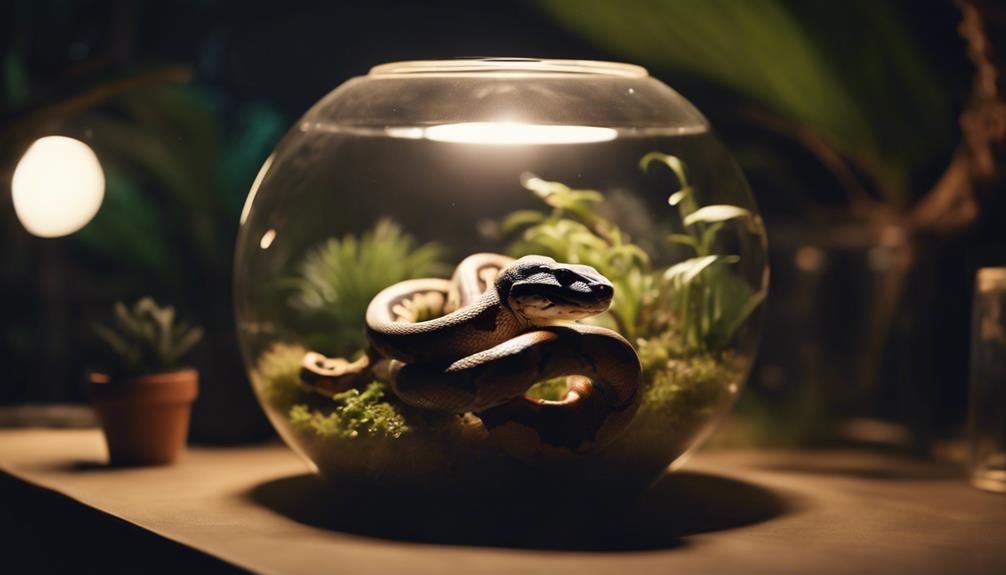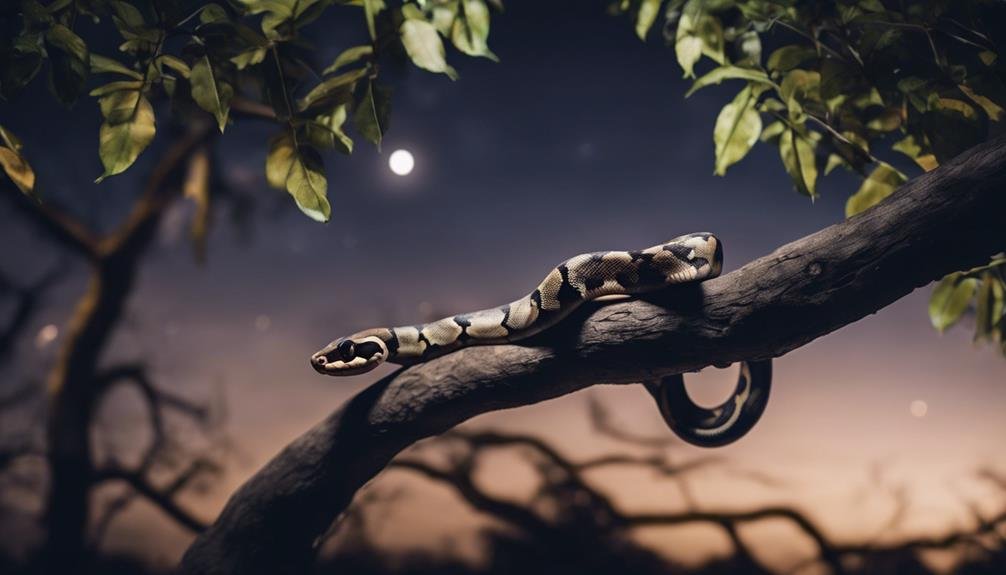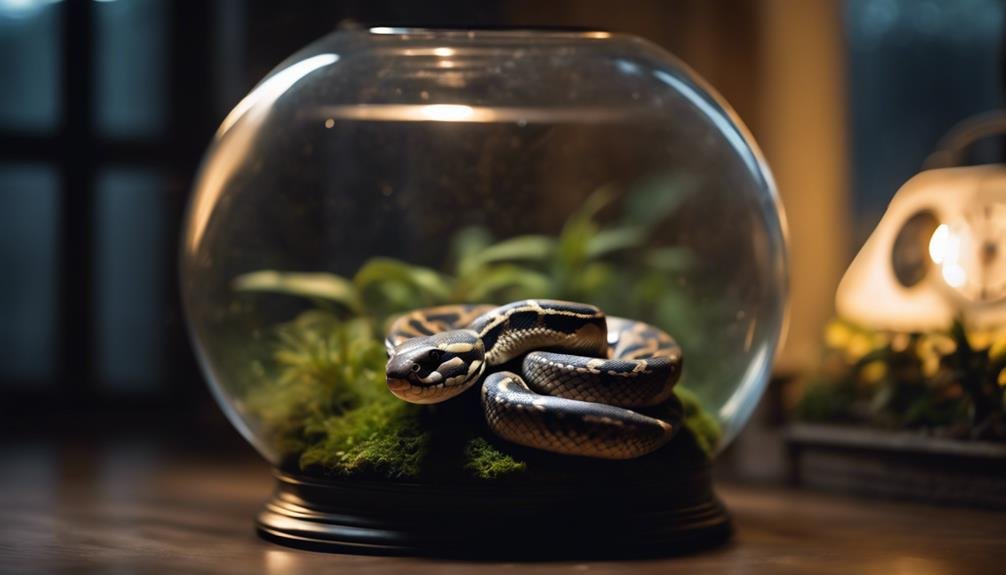You've probably noticed your ball python is more active at night, slithering around its enclosure when the sun goes down. This nocturnal behavior isn't just a preference; it's a survival strategy deeply ingrained in their DNA, allowing them to hunt under the cover of darkness and avoid predators. But what happens when this nighttime activity spills into the daylight hours? Is it a sign of stress, or merely an adaptation to captivity? As you explore the nuances of your ball python's behavior, you'll uncover more than just the reasons behind their nocturnal nature. You'll also discover how to make sure their environment mirrors their natural habitat as closely as possible, promoting a healthy, active lifestyle that respects their inherent tendencies. Let's peel back the layers of mystery surrounding these fascinating creatures and their noisy nights and mornings.
Key Takeaways
- Ball pythons are primarily nocturnal, being most active at night for hunting and exploring.
- Their nocturnal behavior in captivity can lead to noisy nights as they move around.
- Environmental factors, including lighting and temperature, significantly influence their nocturnal patterns.
- Creating a natural day-night cycle in their habitat supports their nocturnal lifestyle.
- Observing their behavior at night can provide insights into their natural habits and needs.
Understanding Nocturnal Behaviors
To fully understand why ball pythons are most active at night, it's essential to explore their nocturnal behaviors. These behaviors aren't just random; they're a well-honed adaptation to their environment. Being nocturnal allows ball pythons to thrive in their natural habitat. At night, their activity spikes, which includes hunting for food, exploring their surroundings, and moving about more freely. This isn't just a preference; it's a survival strategy. By limiting their activity to the night, they avoid predators that are more active during the day. This adaptation also helps them regulate their body temperature, as the cooler night air is more conducive to their physiological needs.
Their environment plays a key role in shaping this nocturnal lifestyle. In the wild, the cover of darkness provides safety and opportunities to hunt without the threat of larger predators. This behavior carries over to captive ball pythons, who still exhibit increased movement and exploration after dark. Understanding this, you can see why providing a dimly lit and quiet environment during their active hours can support their natural behaviors, making them feel more at home and reducing stress.
Salazar's Unusual Daytime Activity
You might find it surprising that Salazar, a young ball python, is wandering around during the day. This shift from his usual nocturnal behavior could mean you need to adjust his care routine.
Let's explore how Salazar's daylight exploration and uncommon behavioral patterns might prompt modifications to guarantee his well-being.
Salazar's Daylight Exploration
Although typically nocturnal, Salazar, the ball python, has recently begun exploring his tank during daylight hours, marking a notable shift in his behavior. This unusual daytime activity, including a refusal to eat, diverges from the expected behavior of ball pythons, who are generally more active at night.
The introduction of a new heat bulb in his tank environment could be influencing Salazar's exploration and behavior change. It's crucial to keep an eye on his health, closely monitor his environment, and adjust his feeding schedule as needed to address this sudden alteration.
Understanding why Salazar is displaying such unusual behavior during the day, when he should be resting, is important for ensuring his well-being and maintaining a healthy tank environment.
Uncommon Behavioral Patterns
Salazar's recent shift to being active during daylight, a stark contrast to his usual nocturnal habits, has caught everyone's attention. This unusual behavior defies the typical nocturnal nature of ball pythons. Despite the introduction of a new heat bulb in Salazar's tank environment, which might be influencing his daytime activity, his refusal to eat is alarming. Instead of hiding, Salazar is now cruising around the tank and exploring different spots.
- *Witnessing Salazar abandon his nocturnal nature evokes concern and curiosity.*
- *His refusal to eat adds a layer of worry about his health.*
- *The sight of him exploring spots during the day is unexpectedly heartwarming.*
- *Observing these behavioral patterns prompts a reevaluation of what's understood about ball python habits.*
Adjusting Care Routines
Acknowledging Salazar's shift to daytime activity, it's important to reexamine and adjust your care routines to support his health and comfort. You've noticed changes in his activity patterns, possibly due to environment changes or disruptions. It's vital to monitor his behavior closely and tweak your care routines accordingly.
| Aspect | Original Care | Adjusted Care |
|---|---|---|
| Temperature Gradients | Stable, but focused on nighttime | Ensure 24-hour access to proper gradients |
| Hiding Spots | Primarily in cool areas | Add more options in warm areas too |
| Lighting | Nighttime emphasis | Provide dim daytime lighting |
| Monitoring | Periodic checks | Frequent observation of activities |
| Environment | Static | Dynamic, adjusting to Salazar's needs |
Understanding Salazar's individual preferences and ensuring his captivity comfort can promote healthier nocturnal behavior, enhancing both your experiences.
The Impact of Environmental Changes
You've seen how Salazar's daytime activity was unusual for a ball python.
Now, let's look at how changes in their environment, like temperature shifts, lighting, and habitat alterations, can influence their behavior.
Understanding these impacts is essential for keeping your snake healthy and active at the right times.
Temperature Shift Effects
Temperature shifts can greatly disrupt a ball python's naturally nocturnal behavior, leading to noticeable changes in their activity patterns. When the environment inside their tank changes unexpectedly, you might notice your snake exploring more during what should be their resting hours. This increase in movement isn't just random; it's a direct response to the discomfort they feel from the temperature fluctuations.
- Temperature changes can push your ball python into unusual hours of increased activity levels, interrupting their normal nocturnal behavior.
- Sudden environmental fluctuations may lead to noisy nights and morning reactions as your snake adjusts.
- Monitoring tank temperature closely helps in sustaining your ball python's natural nocturnal activity, keeping their routine consistent.
- Temperature shifts demand your attention to prevent distress and maintain the well-being of your nocturnal companion.
Lighting Influence
Just as temperature shifts can disturb your ball python's routine, improper lighting greatly impacts their nocturnal lifestyle. Changes in lighting can disrupt their natural behavior, causing stress and altering their activity patterns. Ball pythons thrive in low light levels, where they feel secure and can exhibit typical behaviors without stress. Without adequate darkness, they might become more active during the day, leading to potential feeding issues. Maintaining a proper day-night cycle with appropriate lighting is crucial for your ball python's well-being.
| Factor | Impact on Ball Python |
|---|---|
| Excessive/Inconsistent Lighting | Stress; Altered Activity |
| Low Light Levels | Security; Typical Behavior |
| Inadequate Darkness | Increased Daytime Activity |
| Proper Day-Night Cycle | Well-being; Reduced Feeding Issues |
| Disrupted Natural Behavior | Stress; Feeding Issues |
Habitat Alteration Response
When the environment inside a ball python's habitat changes, such as adjustments in temperature, humidity, or lighting, they often respond by altering their behavior. These behavior changes are a direct response to environmental factors, highlighting the importance of monitoring and making the necessary habitat adjustments to maintain ideal conditions. By understanding how temperature, humidity, lighting, and hiding spots influence a ball python's activity levels and behavior patterns, you can guarantee their well-being.
- Feeling helpless as your ball python retreats more into hiding spots due to uncomfortable temperature and humidity.
- Worrying over sudden behavior changes signaling stress from inadequate environmental conditions.
- Observing fluctuations in activity levels that can leave you puzzled.
- Experiencing joy when achieving the ideal conditions that promote natural behavior patterns in your ball pythons.
Nocturnal Vs. Diurnal Patterns
Ball pythons primarily exhibit crepuscular behavior, being most active at dawn and dusk, but they can also show nocturnal and, to a lesser extent, diurnal patterns. You'll find that their activity isn't just random. Instead, it's influenced by a mix of factors, including the time of day, prey availability, and environmental conditions. When in the wild, they adjust their schedules based on these factors, but even in captivity, they might surprise you with some daylight activity, particularly around feeding times or when they're basking.
Here's a quick glance at how their activity patterns break down:
| Activity Time | Behavior |
|---|---|
| Crepuscular | Most active during dawn and dusk, seeking prey or warmth. |
| Nocturnal | Active at night, exploring and hunting in the safety of darkness. |
| Diurnal | Less common, but may be seen during daylight hours, especially in captivity for basking or feeding. |
| Influences | Environmental factors and prey availability play significant roles in determining their active periods. |
Understanding these patterns helps you create a more natural and enriching environment for your ball python, ensuring they're as healthy and happy as possible.
Observing Your Ball Python


Observing your ball python's nocturnal activities can reveal intriguing aspects of their natural behavior. As these creatures are primarily nocturnal, you'll find that they become more active at night. This shift to increased activity levels when the sun goes down is a vital aspect of their behavior patterns, offering a unique insight into how they interact with their environment.
Creating a suitable environment that mimics their natural habitat is essential. This includes providing ample hiding spots and making sure their enclosure is comfortable and dark during nighttime hours. Observing your ball python's behavior in such an environment can help you understand their needs better and adjust their habitat to support their nocturnal lifestyle.
- Discover the mystery of the night: Watching your ball python explore and become lively after dark is an engaging experience.
- Witness their natural instincts in action: Observing their nocturnal behavior offers a glimpse into their survival strategies.
- Strengthen your bond: Spending time understanding their active periods at night can deepen your connection.
- Create a haven: Tailoring their environment to support their nighttime activities ensures they feel safe and comfortable.
Understanding and observing your ball python's nocturnal behavior patterns is essential for their well-being, providing them with a comfortable environment that caters to their natural instincts.
Do Ball Pythons Tend to Be Nocturnal When Burrowing or Hiding?
Yes, ball pythons tend to exhibit nocturnal behavior when burrowing or hiding. This is a typical ball python burrowing behavior, as they are naturally shy and prefer to be active during the nighttime. Providing them with a dark, secure hiding spot will help them feel more comfortable and secure.
Adjusting Care for Optimal Health
To guarantee your ball python thrives, it's vital to customize their care to match their crepuscular activity patterns. Since they're most active at dawn and dusk, adjusting their environment to mimic these natural cycles plays an important role in their well-being. Implementing a consistent day-night cycle with appropriate lighting ensures they can engage in their natural behavior, contributing to their best health.
A comfortable and secure hiding spot is indispensable for their daytime rest. It allows them to retreat and recover, respecting their need for privacy and security during less active hours. This not only supports their well-being but also mimics the shelter they'd seek in their natural habitat.
Monitoring your ball python's behavior is key to understanding their needs and ensuring they're at their healthiest. By observing how they use their hiding spot and react to the day-night cycle you've set up, you can make necessary adjustments to their care. This proactive approach ensures their activity patterns are supported, leading to a healthier and happier ball python. Remember, understanding and respecting their crepuscular nature by adjusting their care accordingly is fundamental to their best health.
Noisy Nights Explained


If you've noticed your ball python is more active at night, it might be engaging in less common nocturnal behaviors. While ball pythons are primarily crepuscular, their nocturnal activities can sometimes surprise you. These night-time behaviors can include exploring their environment in search of prey or simply moving around more than during the day. It's intriguing to observe, but you might wonder what triggers this shift from their usual dusk and dawn activity patterns.
- The quiet rustle of your ball python exploring at night can evoke a sense of mystery and intrigue.
- The sudden movement in the dark, as it seeks out prey, might startle you but also deepens your appreciation for its natural instincts.
- Observing nocturnal feeding can be a rare treat, offering a glimpse into the less seen, primal side of your pet.
- The disruption of its daytime resting by accidental disturbances can lead to unexpected nocturnal behavior, eliciting concern and curiosity about its well-being.
Understanding that nocturnal behavior in ball pythons can be less common and often spurred by disturbances or the natural drive to hunt helps you appreciate the complexity and adaptability of these fascinating creatures.
Conclusion
So, you've dived into the nocturnal world of ball pythons, uncovering why their night-time antics are just part of their charm.
Remember, Salazar's daytime exploration or those unexpected noisy nights are all clues to their well-being.
Adjusting their care to match their natural rhythms isn't just advantageous; it's essential.
Keep an eye on their behavior, tweak the environment as needed, and you'll guarantee your slithery friend thrives, embracing the quiet darkness they love so much.


